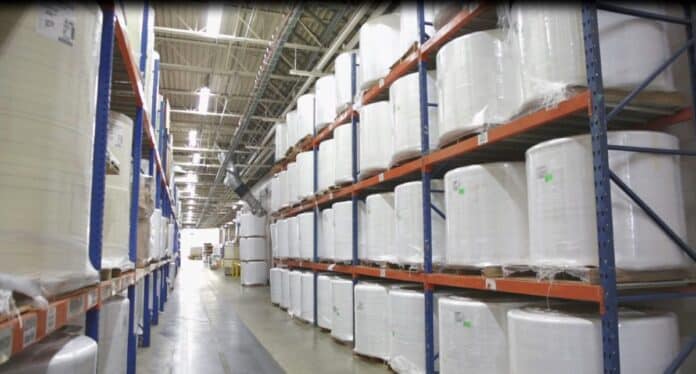
A collaboration between Cummins and the Carbon Fiber Technology Facility at the Department of Energy’s Oak Ridge National Laboratory has resulted in the ability to produce enough filter media to supply more than a million face masks and respirators per day to U.S. healthcare facilities.
As a leading manufacturer of air, fuel and lube filtration products for heavy-duty diesel engines, Cummins officials said they began exploring ways to use their filtration production technology to support health care providers as they addressed the COVID-19 pandemic.
"Because of our expertise in the automotive filtration industry, we believed we could adapt to supply the filter media used in the face masks worn by health care providers, which are also in high demand across the nation,” said Christopher Holm, director of filter media technology and IP at Cummins.
At the same time, the laboratory was searching for ways to scale up production of face masks with equipment used to mass produce precursor material for carbon fiber production at the carbon fibre facility.
[sc:text-divider text-divider-title=”Story continues below gallery” ]
Oak Ridge’s research team had been working with the inventor of N95 filter media, Dr. Peter Tsai, to develop a novel in-line charging device that could be placed on the precursor production line to electrostatically charge the melt-blown material made of polypropylene or PP.
Melt blowing is a nonwoven process that makes microfibers into a fabric by extruding, drawing and scattering a polymer resin with high velocity air and making a randomly deposited sheet of fibrous material applicable for filtration. By electrostatically charging the material with millions of microfibers layered on top of each other, the filter can remove more than 95 percent of submicron particles and viruses such as COVID-19.
"We reached our target goal in only a few weeks on pilot scale melt blowing capability and had the capability to produce filter media for 9,000 masks per hour when we connected with Cummins for potential technology transfer and scale up,” said Merlin Theodore, director of the Carbon Fiber Technology Facility. “Cummins was an ideal partner to scale what we had accomplished and helped us produce material that passed all required testing for filter media.”
With a filtration site in Cookeville, Tennessee just a short drive from the Oak Ridge location, Holm said that Oak Ridge facility was the right fit not only in proximity, but also in research expertise.
“We had the nation’s experts in material science and fiber technology located about an hour from our primary production location,” said Holm. “And, as fate would have it, ORNL was already working with the inventor of N95, Dr. Peter Tsai. Their research has made it possible to be where we are today. We can manufacture material that has passed all the required testing for N95 filter media.”
Cummins and Oak Ridge have a long collaborative history, having partnered to develop a method that repairs a diesel engine cylinder head on heavy-duty engines by additive manufacturing and creating a probe to optimize the engine efficiency among other projects.
The filter media project marks the first time Cummins has collaborated with the Carbon Fiber Technology Facility at the Department of Energy’s Oak Ridge National Laboratory (ORNL).
Just two months ago, Cummins had never produced filter media for face masks and today the company has shipped material to multiple customers across the country for the production of millions of masks.
“We knew melt blowing, but we could not have gotten up-to-speed without the interactions with ORNL and Dr. Tsai,” Holm said. “Their technical guidance helped us become operational in a short amount of time so that we could meet the demand and supply our customers with material during a time of crisis.”
The Oak Ridge research team designed and manufactured a custom electrostatic charging device for Cummins and assisted in the installation of the device on the company’s Cookeville facility production line.
“We’re now looking for opportunities to expand the scope and performance of the materials we’re making, so we can serve even broader needs in the future,” Holm said.
According to Theodore, industry collaborations like this are the reason national lab user facilities exist.
“Our goal is to transfer our technology to industry partners to increase U.S. competitiveness in manufacturing,” she said. “This in turn supplies a critical need for our country, creates job growth and stimulates the economy. We are the catalyst that help industry bring technology to the consumer.”
[sc:pullout-title pullout-title=”About Cummins” ][sc:pullout-text-begin]
About Cummins Inc.
Cummins Inc. is a global technology company designing, manufacturing, distributing and servicing a broad portfolio of reliable, clean power solutions; including diesel, natural gas, hybrid, electric and other alternative solutions. Established in 1919 and headquartered in Columbus, Indiana (U.S.), Cummins serves customers in more than 190 countries and territories around the world.
[sc:pullout-text-end][sc:pullout-title pullout-title=”About Oak Ridge National Laboratory” ][sc:pullout-text-begin]
Oak Ridge National Laboratory COVID-19 manufacturing efforts are conducted in coordination with the U.S. Department of Health and Human Services and funded in part by the Department of Energy Office of Science through the National Virtual Biotechnology Laboratory, a consortium of national laboratories focused on response to COVID-19, with funding provided by the Coronavirus CARES Act.
The Carbon Fiber Technology Facility at Oak Ridge National Laboratory is supported by the Office Energy Efficiency and Renewable Energy’s Advanced Manufacturing Office and the Vehicle Technologies Office. For more information, visit https://energy.gov/science/.
[sc:pullout-text-end]




